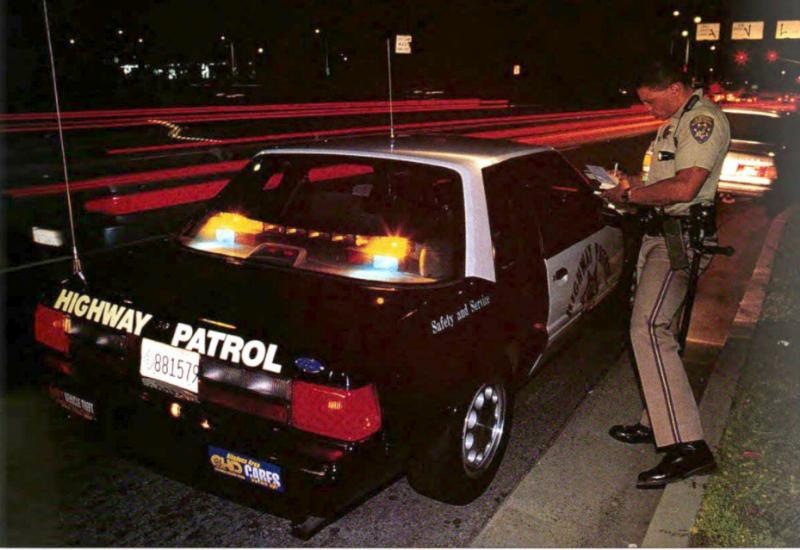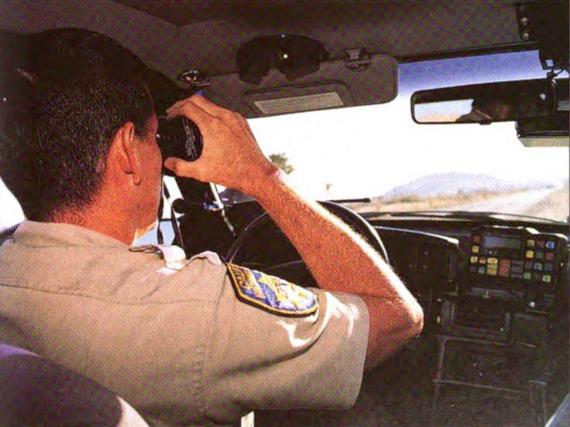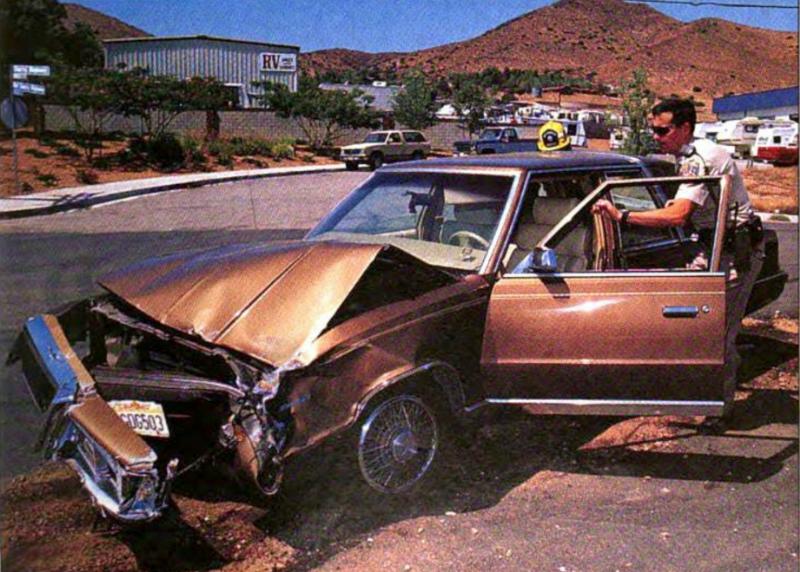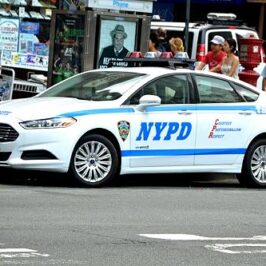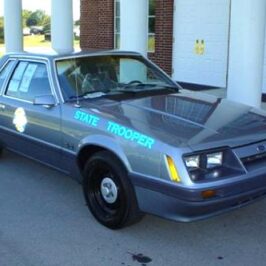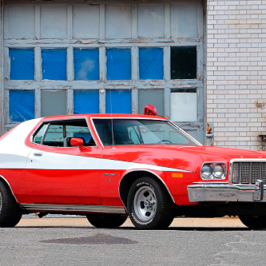Officer Garrett appreciates a fast car-like his CHP Mustang, which is one of the few left in CHP’s fleet.
“Don’t let them kill you on some dirty freeway.”
This is the last sentence of a 5-paragraph survival creed that I read more than 7 hours ago in the briefing room in the Altadena California Highway Patrol Station. The creed hangs on the wall as an ominous reminder that this is serious business. Deadly serious.
It’s now after 9 pm, and we’ve just pulled over a faded green Volkswagen Jetta to the shoulder of the westbound 210 freeway. The car is wearing an expired registration. Since our 8-hour shift began at 2 pm, we’ve pulled over about a dozen cars without serious incident. But for some reason, this one feels different. Maybe it’s me. I don’t know, but I have a bad feeling. Maybe it’s because the Jetta’s backlite is heavily tinted, making it impossible for me to see how many people are in the car, or what they’re doing. Maybe it’s because this is probably our last stop of the night. Or maybe it’s just because my bulletproof vest is itching the hell out of me. Whatever the reason, I keep my trembling nerves to myself.
Officer Mark Garrett, a 5-year veteran of the CHP, runs the Jetta’s license plate over the radio first, which he explains could save him a contact with the motorist. “And the less contact you have, the less chance you have of getting shot,” he adds rather nonchalantly.
“Don’t let them kill you on some dirty freeway,” I remind him. He winks, closes the Mustang’s door and cautiously approaches the passenger window of the Volkswagen.
My job is to sit in the car.
Earlier, Garrett told me what to do in case of a problem. “The radio is your best weapon,” he said. “Push the button, tell them our car number, our location and that an officer is down. If you’re forced to defend yourself, here’s the button to release the shotgun.” Garrett removes the Remington 12-gauge pump gun from its dashboard mount and continues the lesson that I know may be the difference between my life and my death. “There are four in the tube. Pump it once and you’re ready to rock. But watch it, it kicks like a son of a buck.”
All of this-and several of the uglier scenes from the TV show “COPS”-races through my mind as Garrett makes what turns out to be a routine stop. The guy apparently decided to spend his money at the local bar instead of the DMV. So much for my gut instinct.
Eight hours riding shotgun with Officer Garrett and the eight I spend the following night patrolling with Officer Charles Gilliland-cruising the many 2-lanes of the Antelope Valley, northeast of Los Angeles, in his state-issued pursuit Mustang-test my nerves more times than I can count. With each traffic stop, I ask myself, is this going to be a nice, normal person who just didn’t see that stop sign back there? Or is it the kind of trigger-happy freako who’s pissed off at the world, the kind of wacko you see on the news every night? There is no way of knowing until Garrett or Gilliland walks up to that stranger’s window.
On Routine Patrol – July 19, 3:08 pm
First, we make an initial sweep of our beat, which tonight will keep us on stretches of the 210 and 134 freeways. “First we check everything out,” Garrett says. “I haven’t worked for a couple of days, so maybe they started construction on a ramp, or there’s an abandoned car on a shoulder that I’m not aware of. The last thing I want is to be chasing somebody and come across a stretch of road I’m unfamiliar with. I always want to know what’s coming up.” His eyes, partially hidden behind Oakley wraparounds, are constantly scanning the terrain and the other vehicles around us. He’s calm, but alert. Very alert.
The 33-year-old officer drives the Mustang aggressively, but he’s not hard on the equipment. His shifts through the 5-speed manual are not rushed, and his use of the clutch is even delicate. The 5.0-liter small-block V8, however, isn’t exactly babied. Fourth gear on the freeway is the norm. Even in the left lane at 85 mph, where it’s tached up around 3500 rpm. Garrett explains, “Fifth gear is real tall in this thing, too tall for quick acceleration on the highway, and too tall to take advantage of any engine braking in case I need to slow or stop rapidly.”
The stock V8, which does benefit from a heavy-duty cooling system, also endures constant use of the air conditioning, dozens of stops and often up to a half-hour of idling while Garrett writes out an accident report or a stinging speeding ticket. In addition, the engine lugs 200 pounds of safety gear (fire extinguisher, road flares, shovel, water and so on) in the trunk, and 300 pounds of radio equipment, a shotgun, spotlights and other assorted gizmos.
This 1993 Mustang we’re in has 33,135 miles on it, which probably makes it one of the youngest in the small, and rapidly shrinking, California Highway Patrol Mustang fleet. Once the Stang’s odo hits 110,000 miles, it’s off to the glue factory for one more of the 2502 Mustangs that have served the CHP since the program began in 1982. Only 238 are still cruising the freeways. Garrett plans on keeping this one around and under his butt for as long as he can. Once it’s gone, he’s sure to be driving a Ford Crown Victoria or a Chevrolet Tahoe sport/utility vehicle (which the CHP began testing in November) 8 hours a day. And no Crown Vic or Tahoe will accelerate from 85 to 110 mph like this Mustang just did. Before I even realize that he has spotted a scofflaw, Garrett downshifts the Mustang into Third, redlines the gear and upshifts back to Fourth. The burst of acceleration sucks me back in the seat and holds me there as if Hulk Hogan’s foot is on my chest.
With the speedo at 112 mph and the Mustang darting through holes in the traffic like Barry Sanders heading for the end zone, I’m still wondering who he’s going to bust. Everybody seems to be moving along at the same 70 to 75 mph. Then I see his target-a maroon Nissan Sentra hurrying in the carpool lane. We’re closing fast. With Mr. Sentra still completely oblivious to our presence, Garrett whips the Mustang hard left, over the No. 1 lane and across the garbage-cluttered mini divider separating the carpool lane from the rest of the westbound 210. He pulls up to within 20 ft. of the Nissan’s trunk, jumps on the brakes and hits the lights.
Mr. Sentra wakes up, sees us in his mirror and jams on his brakes, essentially brake-checking Garrett, who is more than ready for it. “That’s why I didn’t pull right up on his bumper,” he says calmly. “Most people, even though they’re already nailed, jam on the brakes when they first see me.”
The Sentra guy pulls over. Using the Mustang’s public-address system, Garrett asks him to pull off the freeway at the next exit and stop at the bottom of the ramp. Most CHP officers killed in the line of duty are not shot, beaten, stabbed or poisoned. They’re run over by oncoming cars during routine traffic stops. For this reason, Garrett makes as many stops as possible pull off the freeway.
Among the slow-moving city traffic of Baldwin Avenue, Garrett hands the driver a ticket for 82 in a 65.
On Routine Patrol – July 19, 6:11 pm
“98-65 Los Angeles, 1179 westbound 210 at 134 Crossover.”
The call squawks over the radio. I understand none of it, but Garrett does. He immediately downshifts the Mustang to Third, hammers the throttle and begins threading the needle at more than 100 mph. He explains the call: 98 is the area-in this case Altadena is our car number, and 1179 is an accident with an ambulance responding. We’re Code 3. That means lights and sirens. Garrett has the car in Fifth gear at more than 110 mph and he’s using all four lanes-and at times the carpool lane-to carve his way through the westbound 210 traffic.
My left leg is braced hard against the Remington 12-gauge, my right hand clutching the Mustang’s door panel. Garrett finds the holes in traffic like Dale Earnhardt on the banks of Daytona. And he zips through them before the zombies in their minivans even know he’s coming.
We’re the first to reach the scene. Some guy in an already dilapidated BMW 320i has gotten his car up on the embankment and rolled it several times. He’s okay, but his front teeth are knocked out. That reminds me of another line from the survival creed: “If your attacker kicks your teeth out, swallow them and keep fighting.”
Garrett directs traffic, sweeps the glass and blood out of the No. 2 lane and calls the tow truck. Before it shows, however, our backup arrives in a Chevrolet Caprice, and I’m given a firsthand demonstration of one of the Mustang’s shortcomings in normal police duty. With its big pushbars, 2-ton curb weight, torquey small-block 350-cube Chevy V8 and 4-speed automatic, the Caprice shoves the mangled BMW out of the road and onto the shoulder like Chris Farley body-checking Emanuel Lewis. The little Mustang with its plastic fascia couldn’t have done this.
Within a half-hour, we’re back out doing routine patrol.
On Routine Patrol – July 19, 8:28 pm
“Wow, that homeboy’s smokin’,” Garrett blurts out with the enthusiasm of a teenage boy thumbing through the Pamela Lee issue of Playboy. He’s referring to the BMW 733i that just blew by in the No. 1 lane. We hit it. Garrett puts the speedo on 100 and gives chase. We’re in hot pursuit, but then the BMW vanishes. This stretch of freeway has a curve to it, so before Garrett is able to get up to speed, the Bimmer disappears around the bend. Garrett puts the speedo on 110.
The car is rock solid. Even lane changes at this speed are no cause for alarm, which is surprising, because the suspension is stock, and the state shods these cars with General XP2000 tires. These are respectable general-use tires, but they are certainly not known for high-performance handling prowess. Garrett’s movements of the steering wheel and other controls are precise and well-calculated, which I attribute to his hours of driver training and many miles in his personal ride, a 450-hp Vortec supercharged 5.0-liter Mustang GT.
Half a minute at a buck-ten and still no BMW. “He got off at Birkshire,” Garrett says, which is the ramp we just flew by. “He may live there, or he saw us.” Garrett puts his foot in it. Fifth gear, 120 mph. We get off at the next exit and quickly get back on, but we don’t merge. Garrett parks it at the top of the ramp. “If he was trying to lose me,” he says, “he’ll be by in a minute.”
Sure enough, there he goes. And he’s on it. Garrett guesses the BMW is doing 100 mph, and then he redlines four gears, threads the needle and nails the guy for 85 in a 65.
Garrett in the process of sending another driver to traffic school and higher insurance rates.
Stationary Surveillance – July 20, 3:53 pm
Officer Gilliland looks for scofflaws a mile down the road.
“We’ve got another one. He even made a westbounder nail the brakes and head for the shoulder,” says Officer Gilliland. He’s been looking at the traffic about a mile or so up the road through binoculars, waiting for impatience to send somebody out over the double yellow line separating the two lanes of the 138. A red Toyota 4-Runner Gilliland has been eyeballing cruises by, its driver completely unaware of her impending brush with the law.
Forty-seven-year-old Officer Gilliland is in his 17th year with the CHP, his ninth in the desert landscape of the Antelope Valley, where he has lived since 1959. Before serving the people of his community, Gilliland put in eight years on the ugly streets of downtown Los Angeles.
When a hole appears in the traffic, Gilliland revs the Mustang, drops the clutch like “Big Daddy” Don Garlits and cranks the wheel left. The rear tires spit dirt from the soft shoulder, hit pavement and toss the car around in a sideways 180 degree spin right out of “Starsky And Hutch.” I’m pinned to the door panel. Gilliland dials in opposite lock, straightens the car out and hammers the gas. We’re in hot pursuit.
Three firm gear changes later, we’re closing in fast on the 4-Runner. Gilliland holds the Mustang at 90 mph and contemplates how he’s going to get around the three cars between him and the red Toyota. I notice that this Mustang, which has 88,540 miles on it, doesn’t feel as solid as the one I was in yesterday. It’s also not as clean, and its paint and interior aren’t as well kept. Gilliland says the car rolls for 100 to 200 miles a shift, two shifts a day. No Mustangs are used on the graveyard shift when CHP procedure dictates two officers to a vehicle. The car is simply too small.
The three cars separating us from the prey see us coming. Each lets us by without any problems. But getting the 4-Runner to pull over is another story. The driver is a 30-something woman who’s paying more attention to her CD player than the road. Our flashing lights and two bursts of the siren don’t even wake her up. Finally, after more than a mile, she spots her future of heavy fines and endless insurance surcharges. Gilliland writes her up for driving left of the solid yellow line and not using her seatbelt.
On Routine Patrol – July 20, 9:14 pm
Gilliland knows the endless 2-lane ribbons running through the valley like the Duke boys know Hazzard County. He makes lefts and rights on streets named Pallet Creek, Longview, Tumbleweed and Devil’s Punchbowl.
We’ve just dropped down out of the mountains, and landed in downtown Palmdale. Gilliland believes in high-visibility enforcement. We cruise through a few parking lots and go down a few alleys. He believes that just making his presence known is enough to prevent trouble. We find nothing. It’s a quiet night. No 2-11 (armed robbery) in progress. No deuce (drunk driver).
Then, a Honda Civic with oversize wheels and tires and an exhaust pipe big enough to swallow my foot buzzes by at 70 mph. Gilliland hits the lights and the gas. When the Civic pulls over at the corner of P-8 Street and 5th Street West, we hit his rearview mirror with the spotlight. Blinds him good.
In case of trouble, I make sure I’m aware of our location and the location of the shotgun release button. Gilliland returns. “I’m just going to give him a warning,” he says, “but let’s chat for a while, make him sweat a bit.”
After about 5 minutes, Gilliland returns the man’s driver’s license and climbs back in the Mustang with the kind of nasty grin that made Jack Nicholson famous. This is a guy who enjoys his work.
Back at the station at 9:52 pm, I peel off the 4-pound bulletproof vest, thankful that I did not need it and thankful that I will not have to put it on again. Garrett and Gilliland, however, will wear theirs again tomorrow. And the night after that. And the night after that. Hopefully, they won’t need theirs either.
Routine for CHP-another day, another wreck on the highway.
BY SCOTT OLDHAM
Photos by Kevin Wing
1993 Popular Hotrodding







